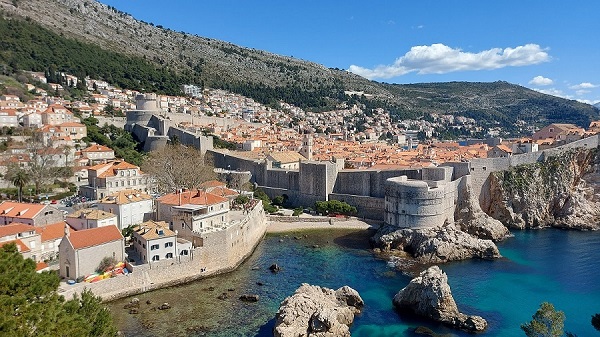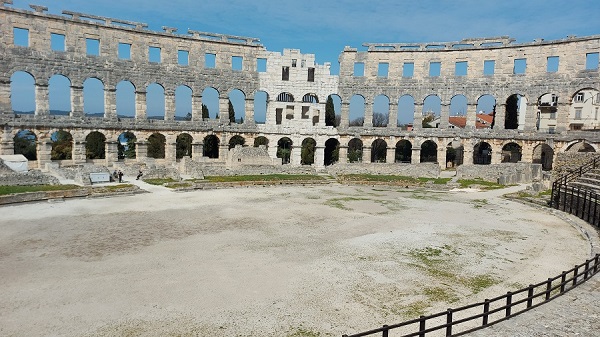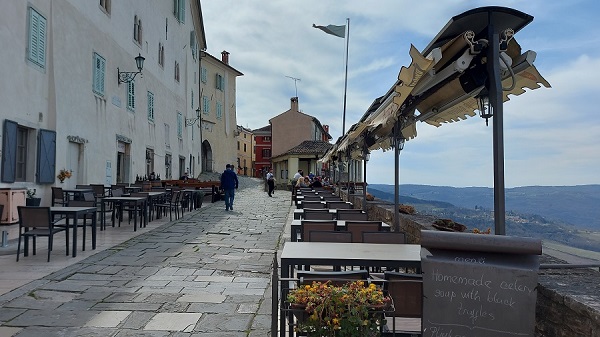Hrvatska is the native name for Croatia, and the Croatian language is called Hrvatski. The Croatian currency was the kuna until the end of 2022 (1 SGD was roughly worth 5.2 kuna at the time); when Croatia became a member of the Schengen Area, the kuna was replaced by the euro. The country lies to the east of Italy on the opposite coast of the Adriatic Sea, and borders Slovenia, Hungary, Serbia, Bosnia and Herzegovina, and Montenegro (clockwise from northwest to southeast). In terms of land area, Croatia is about 77 times larger than Singapore. As of 2021, nearly 90% of Croatians identify themselves as Christians, and about 78% identifying as Roman Catholics.
Getting to know Croatia
Croatia is a country that often comes to my mind when the Balkans (the geographical area encompassing southeastern Europe), or the term "Slavic people" (people who speak the Slavic languages and are distributed throughout Europe) are mentioned. For a brief history of the region, Croatia was originally settled in antiquity, mainly by the ancient tribes of Illyrians and Liburnians, as described in some accounts from sixth century BCE. Around 9 CE, it became part of the Roman Empire up to about fifth century CE. It was generally recognised as an independent area in 879 CE, and then became a kingdom in 925 CE. It entered a state of personal union with Hungary in 1102 CE. The Ottoman Empire held control over parts of Croatia from the 16th century to the end of the 17th century.
In 1918, Croatia merged with other territories to form the Kingdom of Yugoslavia, and later became part of the Socialist Federal Republic of Yugoslavia. In 1991, Croatia declared independence from Yugoslavia and fought what is now called the Croatian War of Independence. When armed conflict finally ended in 1995, Croatia began its post-war reconstruction, including transport infrastructure and facilities for tourists. It is no wonder that tourism is now a major part of its economy.
I toured the western region of Croatia soon after the nation became part of the Schengen Area. My flight had a layover in Frankfurt, Germany, and the total travel time from Singapore to Zagreb's Franjo Tudman Airport took about 18 hours. I stayed one day in Zagreb and got a rented car. The driving route took me through the west coast of Istria along a panoramic road to many locales. In this trip, I toured Rovinj, Porec and Pula; then Opatija and its Croatian Walk of Fame; Fuzine; Motovun; the Kvarner Gulf and Lika region; Zadar; Sibenik and Split; the Neretva and Peljesac area (including Ston); and finally Dubrovnik, before returning to Zagreb. Of these, I highlight three places: Istria, Split and Dubrovnik.
Istria
Istria is the largest peninsula in the Adriatic Sea, between the Gulfs of Trieste and Kvarner. The region is shared with Slovenia and Italy, though 90% of the area belongs to Croatia. The name is thought to have derived from the Histri tribes that lived there (classified by some as "Venetic" Illyrian tribes), or from the Latin name of the Danube river, Ister. Istria was part of Italy in the early 1900s, then Yugoslavia from 1947, and then Croatia after 1991. Thus, there is a Venetian air in Istria. The port town of Rovinj almost feels like Venice on a hill.
Pula is the largest city in Istria County and was the Roman administrative centre of Istria (which was conquered by the Romans around 177 BCE). It is known for its many ancient Roman buildings, particularly the Pula Arena – an amphitheatre which was constructed around 27 BCE to 68 CE. It is the world's sixth largest surviving Roman amphi¬theatre, and one of the best preserved. The underground passages through which animals and gladiators passed into the arena are open to visitors. Later, the arena became a source of stone for construction, and the last time stone was taken was in 1789 for the Pula Cathedral. These days, the arena is used as a venue for concerts.
The City of Motovun is a hilltop town, and is on the UNESCO World Heritage Sites Tentative List. After being taken over by the Kingdom of Venice in 1278, it was surrounded by walls on which one can walk to view the surrounding Mirna river valley. There is a fee to enter the walkway, but I met a friendly local who let me onto the walkway from his home.
In the areas surrounding Motovun, black and white truffles grow and are gathered with the help of trained dogs. Motovun is also the birthplace of the famous racing driver twins, Mario and Aldo Andretti, which is ironic as cars are prohibited in the Old Town, except for those owned by residents and shopkeepers. There is a beautiful and peaceful cemetery at the Church of Saint Margaret, with well-tended graves (many with tombstones listing Italian names) amid cypress trees. One enters the Old Town through the town gates (dating from the 14th to 16th centuries) and can then walk to the Trg Piazza de Soto, where one can enjoy coffee and wine and meals with truffle. At the main square of Trg Andrea Antico, there is the Church of Saint Stephen which was built in the 17th century, but has an older free-standing belltower built in the 13th century.
Split
Split is the second largest city of Croatia after Zagreb, and is the largest city of Dalmatia. The name Split is apparently derived from the spiny broom plant (calicotome spinosa) which grows in that area, and the city is also known by its Italian and Venetian name Spalato.
Dalmatia is one of the four historical regions of Croatia. It is a narrow belt of land from the island of Rab to the Bay of Kotor. The name is derived from another Illyrian tribe, the Dalmatae. The region came under Roman control from about 168 BCE. Most of Dalmatia was ruled by Venice from the 15th to the 18th century. In the 19th century, Dalmatia became a kingdom and part of the Austrian Empire, with its capital at Zadar. Like Istria, the region became part of Yugoslavia, and then part of Croatia after the breakup of Yugoslavia.
Because of its former rulers, Split has a unique mix of architecture and history, next to the turquoise waters of the Adriatic Sea. The top attraction is Diocletian's Palace, a UNESCO World Heritage Site since 1979 and which forms half of the Old Town of Split. It was finished in 305 CE as a retirement home for the Roman emperor Diocletian when he abdicated, although the complex has the feel of a fortress.
Including the residences, there are over 200 buildings within the complex. Within the palace, one can walk along the cardo (the main street) and visit various sites such as the Peristyle (the palace centre), the Vestibule (also known as the Rotunda or Atrium), and the cellars. The cellars had been largely forgotten, as they had collapsed, until the 20th century when they were excavated and cleared, then opened to the public in 1996. The cellars were used as a location for filming HBO's fourth season of Game of Thrones.
The Old Town is also a maze of streets with cafes and restaurants. The Split harbour of Riva is lined with five different palm tree species (planted in 1920), and you can get wonderful views of the Adriatic Sea when strolling on the promenade.
Dubrovnik
Dubrovnik, historically known as Ragusa, is a city in the south of Dalmatia, and was listed as a World Heritage Site in 1979 thanks to its outstanding medieval architecture and old fort. Before reaching Dubrovnik, the Croatian mainland at the Peljesac peninsula is interrupted by a strip of land near the coastal town of Neum (about 47 km from Dubrovnik), which belongs to Bosnia and Herzegovina. Travellers by car to and from Dubrovnik therefore have to pass through two border checkpoints within 9 km of each other. To avoid border crossings, one can now drive across the Peljesac Bridge on the peninsula to Dubrovnik, staying in Croatian territory throughout. This 2,404 metre bridge was opened in 2022.
From the 14th to 19th century, Dubrovnik was part of the Republic of Ragusa, a maritime free state which was in a subordinate relationship with the Ottoman Empire. The Republic reached its peak as a thalassocracy in the 16th century. Both names, Dubrovnik and Ragusa, have co-existed for many centuries. The name Ragusa is recorded in its Greek form, Rhaousin, but its origin is not clear; one suggested derivation is from a Greek term indicating a narrow passage. The name Dubrovnik appears to derive from the Proto-Slavic reconstruction "dobrava", meaning oak forest.
In October 1991, after Croatia declared independence, Dubrovnik was attacked and many buildings in its Old Town were damaged. The siege of Dubrovnik lasted until May 1992, and some of this damage can still be seen in older buildings.
Located in a seismically active area, much of Dubrovnik was flattened in an earthquake in 1667 (estimated as high as magnitude 10 on the Richter scale) and had to be rebuilt. On 15 April 1979, another massive earthquake (magnitude 7.2 on the Richter scale) badly damaged over 1,000 buildings in the Old Town. Some buildings still show damage from the earthquake as well.
The main attractions in Dubrovnik for me were the walks along the yacht club, Port Gruz, and along the city wall, where you get wonderful views of the Adriatic and the rooftops of the Old Town. The existing walls were built during the 13th to 17th century and are about 2 km long and 25 m tall at their highest. There are also forts within the city wall, including the Minceta Tower, the highest point of the city's defence system, which was completed in 1464.
Other areas of interest include the picturesque Stradun (the Old Town main street) and nearby backstreets, the Dubrovnik Bell Tower at Luza Square, the Franciscan and Dominican monasteries, and the Rector's Palace. A city pass called the "Dubrovnik Pass" available for tourists provides discounted or free admissions to the major sightseeing sites in Dubrovnik. It can be bought online in variants of one-, three- and seven-day passes and can be used with an app. The pass also includes free travel on the local public buses and discounts at various shops.
Several sites within the city walls were also used for the filming of Game of Thrones. There is an official Game of Thrones souvenir shop near the famous Jesuit stairs at Boskoviceva Poljana (Boskovic Square). Fans of the series can search for various companies that offer tours to the filming sites as well.

Dubrovnik city wall walk view

Pula Arena

Motovun square – Trg Piaza de Soto